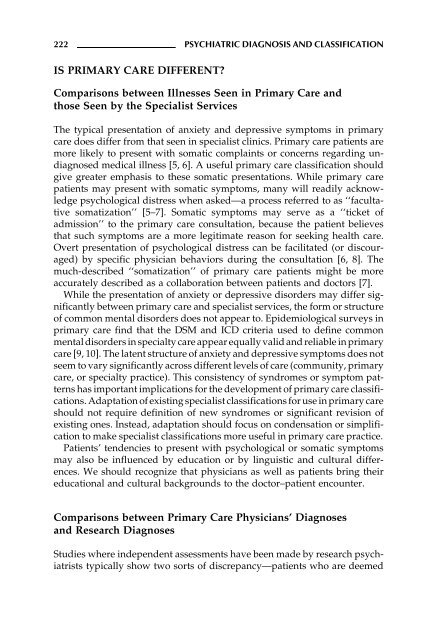Psychiatric Diagnosis and Classification - ResearchGate
Psychiatric Diagnosis and Classification - ResearchGate
Psychiatric Diagnosis and Classification - ResearchGate
You also want an ePaper? Increase the reach of your titles
YUMPU automatically turns print PDFs into web optimized ePapers that Google loves.
222 PSYCHIATRIC DIAGNOSIS AND CLASSIFICATION<br />
IS PRIMARY CARE DIFFERENT<br />
Comparisons between Illnesses Seen in Primary Care <strong>and</strong><br />
those Seen by the Specialist Services<br />
The typical presentation of anxiety <strong>and</strong> depressive symptoms in primary<br />
care does differ from that seen in specialist clinics. Primary care patients are<br />
more likely to present with somatic complaints or concerns regarding undiagnosed<br />
medical illness [5, 6]. A useful primary care classification should<br />
give greater emphasis to these somatic presentations. While primary care<br />
patients may present with somatic symptoms, many will readily acknowledge<br />
psychological distress when askedÐa process referred to as ``facultative<br />
somatization'' [5±7]. Somatic symptoms may serve as a ``ticket of<br />
admission'' to the primary care consultation, because the patient believes<br />
that such symptoms are a more legitimate reason for seeking health care.<br />
Overt presentation of psychological distress can be facilitated or discouraged)<br />
by specific physician behaviors during the consultation [6, 8]. The<br />
much-described ``somatization'' of primary care patients might be more<br />
accurately described as a collaboration between patients <strong>and</strong> doctors [7].<br />
While the presentation of anxiety or depressive disorders may differ significantly<br />
between primary care <strong>and</strong> specialist services, the form or structure<br />
of common mental disorders does not appear to. Epidemiological surveys in<br />
primary care find that the DSM <strong>and</strong> ICD criteria used to define common<br />
mental disorders in specialty care appear equally valid <strong>and</strong> reliable in primary<br />
care [9, 10]. The latent structure of anxiety <strong>and</strong> depressive symptoms does not<br />
seem to vary significantly across different levels of care community, primary<br />
care, or specialty practice). This consistency of syndromes or symptom patterns<br />
has important implications for the development of primary care classifications.<br />
Adaptation of existing specialist classifications for use in primary care<br />
should not require definition of new syndromes or significant revision of<br />
existing ones. Instead, adaptation should focus on condensation or simplification<br />
to make specialist classifications more useful in primary care practice.<br />
Patients' tendencies to present with psychological or somatic symptoms<br />
may also be influenced by education or by linguistic <strong>and</strong> cultural differences.<br />
We should recognize that physicians as well as patients bring their<br />
educational <strong>and</strong> cultural backgrounds to the doctor±patient encounter.<br />
Comparisons between Primary Care Physicians' Diagnoses<br />
<strong>and</strong> Research Diagnoses<br />
Studies where independent assessments have been made by research psychiatrists<br />
typically show two sorts of discrepancyÐpatients who are deemed

















